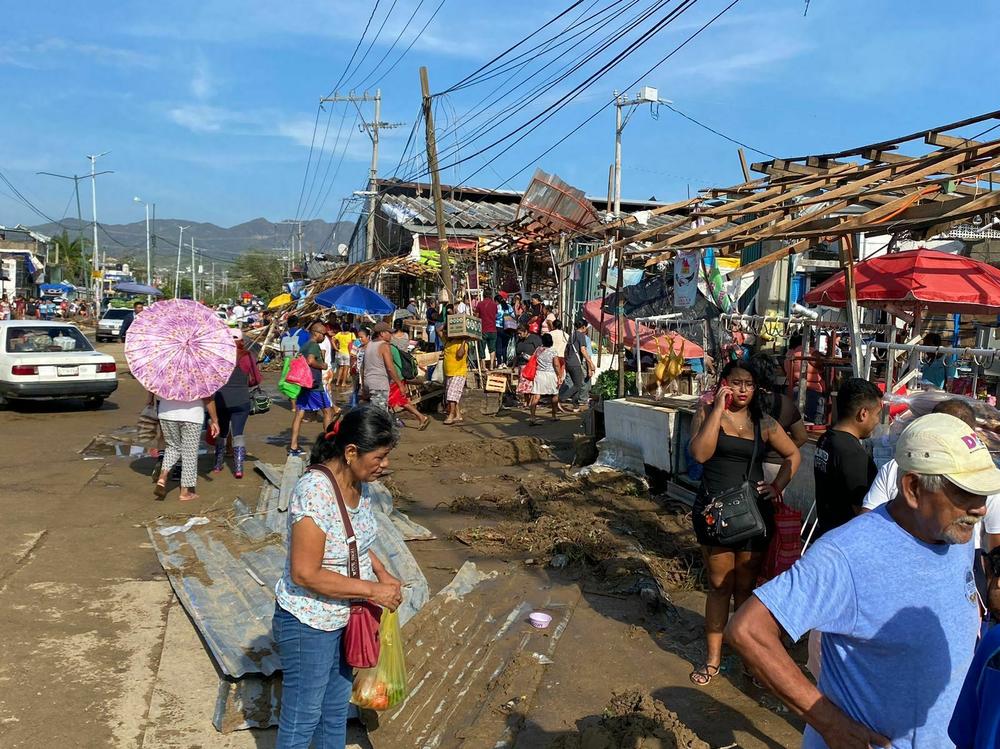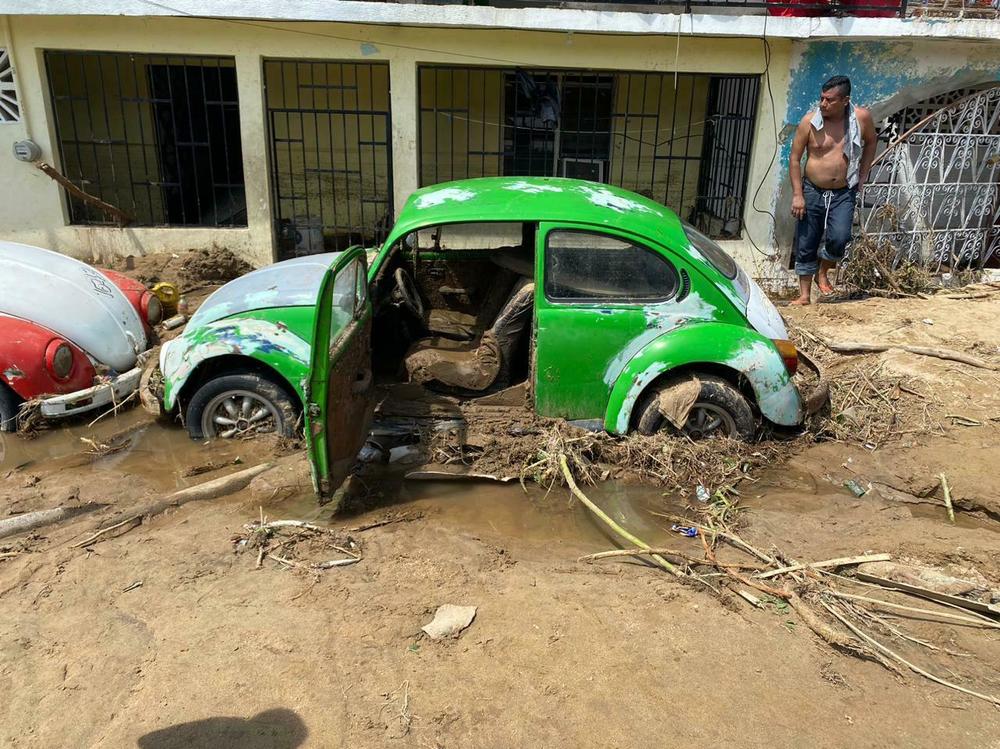Section Branding
Header Content
Mexico's Acapulco grows desperate for help after Hurricane Otis ravaged the area
Primary Content
ACAPULCO, Mexico — As a bright, hot sun filled Acapulco in the days following the furious arrival of Hurricane Otis, it revealed a city utterly transformed by destruction.
The Category 5 storm slammed into the Pacific coast early Wednesday, killing at least 27 people, with at least four still missing, according to Mexican officials.
Mexico's president, Andrés Manuel López Obrador, pledged unlimited resources and thousands of troops. But residents and tourists in the city of 1 million people say they've received scant help.
The surprisingly powerful hurricane left little time to prepare and heavy damage in its wake. That's made it difficult to access the city, leaving Acapulco with challenges of surviving the aftermath and eventually rebuilding the once-glamorous Pacific getaway.
Tourist areas wrecked
As much as 80% of the city's hotels were damaged by the storm, Evelyn Salgado Pineda, governor of Guerrero state, which includes Acapulco, said on Thursday.
As NPR visits, it has found tourist areas devastated. Broken glass filled hotel lobbies. Avenue-lining palm trees were stripped clean or thrown across the road. Winds reaching 165 mph had ripped through beachfront high-rises, hollowing out rooms and leaving buildings skeletal.
Hotel guests said they didn't know how they survived as the furious winds shattered glass and tossed furniture.
"We hid in the bathroom for hours," said Adelita Jiménez, 42, who was with her husband and two teenage children celebrating a family reunion in Acapulco. "We just held onto each other. We didn't know if we would survive."
Tourists went out in search of food, water and any information in the days after the storm. Most were stuck and unsure how to get out of the city.
Jiménez and her family waited at a shuttered gas station for hours, where rumor had it buses would be passing to take stranded tourists out of the city. National Guard troops directing traffic a few feet away had no information about the buses.
Speaking from Acapulco on Friday, Mexican Defense Secretary Luis Cresencio Sandoval said 150 buses have been deployed to take tourists and residents out of the disaster area and 120 more would be sent Friday.
He also said more than 13,000 troops were deployed in the city and working in "a coordinated manner" with local and state officials to "resolve the situation."
Limited commercial flights have resumed at the badly damaged international airport.
President López Obrador, in a Friday morning news conference, urged people in Acapulco not to take advantage of the situation, as people growing desperate for food, water and other provisions have resorted to looting.
Across the city, NPR saw residents and tourists alike looting supermarkets, convenience stores, pharmacies and big box stores. They loaded shopping carts and wheelbarrows with whatever they could grab from shelves. Many said they had no other choice if they wanted to survive.
"We came to get ice because we have meat and fish at home and it's gonna go off," Olivia Bautista, 48, said outside a convenience store on Acapulco's hotel strip. "I've never stolen anything in my life. This is so terrible. We have money but there's nowhere to buy."
Aside from a few stalls selling fresh produce, NPR did not see a single store open in the city on Thursday.
Manuel Magallón, 25, hiding from the sun in a wide-brimmed straw hat, trekked across Acapulco for hours in search of medication for his aunt. She was recently released from a cancer ward at a public hospital, which was sending patients home as it didn't have electricity, Magallón said.
"People are desperate but they are taking whatever they can, even if they don't need it," he said. "My aunt really needs this medication. It's disappointing."
Magallón carried a small cardboard box he had stuffed with antibiotics and painkillers he finally found at a pharmacy near downtown Acapulco's main hotel strip, before walking back across the city to his aunt.
A key problem in Acapulco since the storm hit is the number of roads made impassable by trees, electricity posts and mud.
While crews were working with heavy machinery in a few places, in others, army personnel seemed underresourced. A soldier pounded on a fallen concrete pole with a sledgehammer, trying to gradually break it into manageable pieces. A handful of other troops slashed at a massive fallen tree with machetes in a slow attempt to remove it from the road.
Lines of cars both attempting to enter and exit the city sat in traffic for hours.
Working-class neighborhoods dig out of mud
In the hills above Acapulco's iconic bay, the damage looked different but was equally devastating for the city's working-class residents. Rivers descending from the mountains spilled tremendous amounts of water into densely populated residential areas. Heavy winds ripped tin roofs off of houses and threw water tanks into trees.
In the Zapata neighborhood, thick mud from the river, still more than a foot deep in places, had become the main foe for residents. They trudged back and forth through it barefoot to reach the main avenue. They shoveled it out of their homes into the streets for hours and days.
"I'm so tired," cried Antonia Hernández, carrying her 2-year-old grandson in a diaper while her son and daughter-in-law moved around mud-caked furniture and appliances.
When Hernández looked down into the first floor of her small, cinderblock house as the storm subsided early Wednesday morning, she saw her refrigerator floating on its side in 3 feet of water. Her washing machine, which she had saved for and bought just days before, was filled with mud and destroyed.
"It was so sad to see all my things destroyed like that," she sobbed. "This is just chaos, total chaos."
Since the storm hit, residents in Zapata as well as most guests and workers in the tourist area said they have not seen a helping hand, neither from the government nor aid groups.
In different parts of the city, NPR saw a large presence of Mexico's military clearing roads of trees, power lines and mud as well as the country's national power company attempting to repair downed lines. But NPR did not see any aid in the form of food, water or medical care.
Defense Secretary Crescencio Sandoval said 7,500 provisions have been distributed along with 7,000 liters of water, and that 40 tons of aid was on its way.
"My children screamed and cried because the sounds of the storm were so horrible," said Lourdes Cabello, 36. "Yesterday [the day after the storm] we didn't eat anything. We don't have food. We don't have water. My neighbor gave me this ham so the kids can eat lunch."
Moments later, Cabello was delighted to see her teenage son, covered in mud from head to toe, return from a looted local shop with a case of drinkable yogurts.
Deeper in Zapata, a small river still flowed fast and high and a light muddy brown. The destruction it wrought was overwhelming, countless trees carried down it and thrown into houses and sweeping away half a concrete bridge.
Half a block from the river, Abel Sandoval, 44, emerged from the storm on Wednesday morning to find his classic Volkswagen Beetle taxi partly buried. He opened the door to find it filled with mud.
"It's destroyed," he said. "This is how I make my living. What am I supposed to do now?"
Sandoval headed toward the main road to see what he could find at the local supermarket. But he soon turned back when he saw a neighbor walking toward him.
"Look in my backpack," she said, holding it open for him. "It's empty. There's nothing in the stores anymore. There's nothing here."
NPR's Eyder Peralta contributed reporting from Acapulco.
Copyright 2023 NPR. To see more, visit https://www.npr.org.





